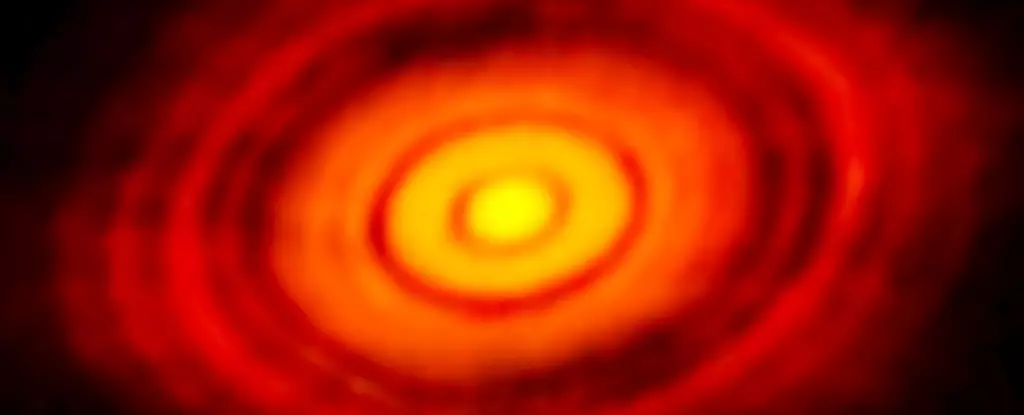How long does planet formation take? Maybe not as long as we thought, according to new research. Observations with the Atacama Large Millimeter/submillimeter Array (ALMA) show that planet formation around young stars may begin much earlier than scientists thought. These new results were presented at the American Astronomical Society’s 243rd Meeting.
The findings presented by Cheng-Han Hsieh, a Ph.D. candidate at Yale, shed light on the early stages of planet formation and challenge our current understanding of the process.
The ALMA images of protoplanetary disks have been capturing attention for years, revealing rings and gaps that scientists believe are potential sites of planet formation. However, these images primarily depict Class 2 disks associated with older stars. The new images from the CAMPOS survey show Class 0 and Class 1 disks, which are significantly younger.
Class 0 and 1 disks correspond to very young stellar objects (YSOs) that are still in the process of collapsing and forming. These YSOs have a limited lifespan as Class 0 objects for about 10,000 years and as Class 1 objects for a few hundred thousand years. Therefore, the presence of rings and gaps within these extremely young stellar objects is unexpected and challenges current theories of planet formation.
There are two primary theories for how planets form: core accretion and gravitational instability. In the core accretion model, rocky cores form from collisions among small planetesimals. Once the core reaches sufficient mass, it begins attracting a gaseous envelope, eventually resulting in the formation of gas giants like Jupiter.
On the other hand, gravitational instability suggests that a protoplanetary disk becomes massive enough to trigger instability, leading to the formation of bound clumps that eventually become planets.
Cheng-Han Hsieh highlights the challenge posed by the newfound rings and gaps in the early protoplanetary disks. According to him, “It is difficult to form giant planets within a million years from the core accretion model.” These early structures could indicate that planet formation begins at an even earlier stage than previously thought, redefining our understanding of the process.
The limitations of the observational resolution should be acknowledged in the interpretation of the new images. Hsieh explains that their angular resolution is around 15 AU (astronomical units), meaning they can only detect substructures like rings and gaps larger than 8 AU. For context, the distance between the Sun and Saturn is approximately 9 AU.
Therefore, their ability to detect substructures is limited to those larger than the distance between the Sun and Saturn. Substructures in the earliest systems might be smaller and therefore go undetected by current observations.
Distinguishing Planet-Forming Structures from Transient Features
Ethan Siegel raises an important question regarding the nature of the observed structures. Are they truly indicative of planet formation or could they be transient features that will dissipate during the evolution of the planetary system?
Hsieh responds, stating that simulations suggest that Earth-sized or Neptune-sized planets inside a protoplanetary disk would accrete gas from the surrounding environment, leading to the carving out of gaps and rings. However, he also notes that other instabilities, such as perturbations in density or temperature, can also contribute to the formation of substructures. Thus, it becomes challenging to definitively attribute the observed substructures to planets or other instabilities.
The distinction between the two possibilities remains a subject of ongoing research.
Regardless of whether the substructures observed in the protoplanetary disks are planets or not, they still hold significance. Hsieh emphasizes the importance of determining when these substructures form as it provides insights into the timescale of planet formation.
The existence of substructures signifies that the protoplanetary disk has reached a sufficiently calm state, with reduced turbulence, allowing structures and planets to initiate formation. Even if the observed features are not actual planets, they indicate that planet formation can commence within approximately 300,000 years of the YSO’s existence.
Future observations and research will be crucial in determining the true nature of these substructures and their role in planet formation.
The latest ALMA observations challenge our understanding of planet formation by suggesting that it may commence much earlier in a solar system’s life. The unexpected presence of rings and gaps in the progenitor disks of Class 0 and Class 1 YSOs raises questions about the prevailing theories of core accretion and gravitational instability.
While our observational capabilities are currently limited, the ongoing investigation of early protoplanetary disks and their substructures provides valuable insights into the formation of planets, regardless of their exact nature. Future research endeavors and advancements in observational technology will contribute to a more comprehensive understanding of the intriguing process of planet formation.



Leave a Reply